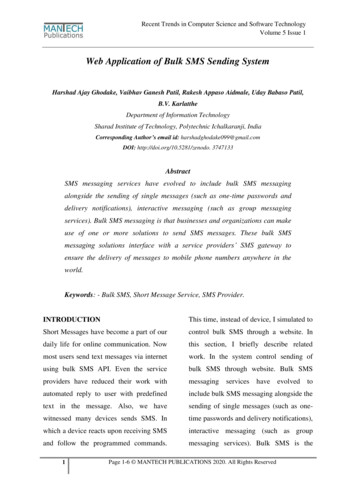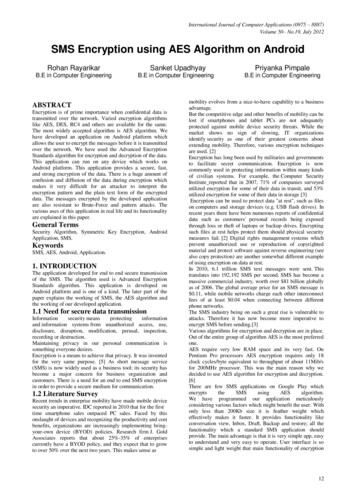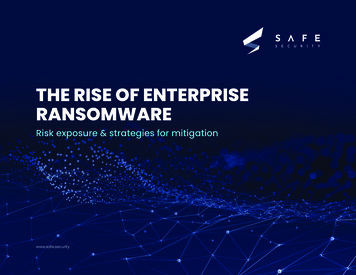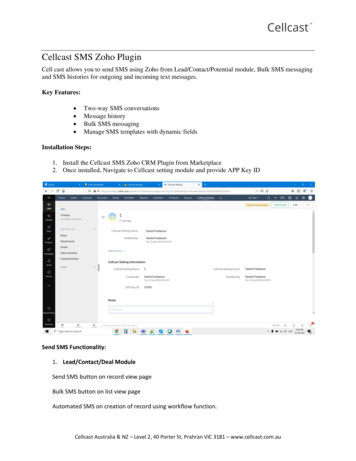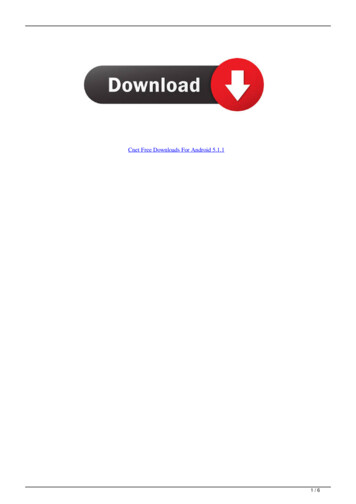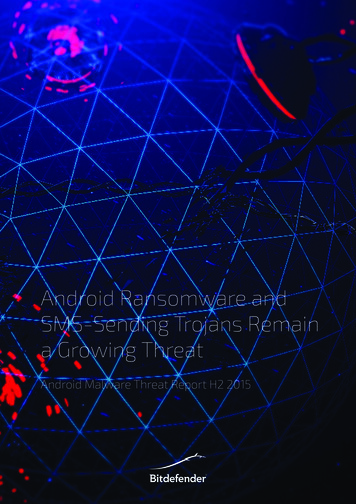
Transcription
Android Ransomware andSMS-Sending Trojans Remaina Growing ThreatAndroid Malware Threat Report H2 2015
ContentsExecutive summary.3Key Findings:.3Ransomware is Good Business.3Android Device Proliferation.4Android Ransomware Evolution.5Distribution and Attack Vectors.7How Victims React to Ransomware .8Top Android Malware Families during Second Half of 2015.9Android Ransomware Scores Big in US and Germany.9SMS-Sending Malware Also Goes for American Money. 10Trojans and Aggressive Adware. 10Fake Apps Making Promises and Delivering Malware. 13Takeaway and How to stay safe?. 15About Bitdefender . 15AuthorLiviu Arsene – Senior E-Threat AnalystTechnical information provided courtesy of Bitdefender Labs.Copying/extracting/republishing parts or entire document is strictly prohibited without PRIOR WRITTEN APPROVAL from Bitdefender.All Rights Reserved. 2016 Bitdefender. All trademarks, trade names, and products referenced herein are property of their respective owners.[2]
Executive summaryRansomware has been plaguing Windows PC for the past couple of years, but recently it seems to have developed platform-agnosticcapabilities and has moved towards Linux and Android.While not yet as advanced as its Windows counterpart, Android ransomware can still cause massive headaches, disruptions andfinancial losses. Bitdefender Android telemetry shows the Android.Trojan.Slocker ransomware family ranked first in UK, German andAustralian charts, based on the number of devices that reported it.Android ransomware could be considered more important than it’s PC counterpart because mobile devices have access to and storea lot of personal and even corporate data that’s usually not backed up. Losing that data or simply being denied access to it could beirreversible and users would be far more inclined to pay to recover their contacts, conversations, pictures and documents.Key Findings:·19.55 percent of global threats are fake apps that install malware or highly aggressive adware;·45.53 percent of all globally reported Android ransomware points to the US;·78.36 percent of all globally SMS-sending malware targets the US;·Ransomware ranks first in Germany, UK and Australia top threats;Ransomware is Good BusinessA Bitdefender study conducted in November 2015 revealed that ransomware victims would be willing to pay up to 500 to recover theirdata.UK 568USA 350Germany 227France 203Romania 1320100200300400500600Ammount respondents would pay54,11%Fig. 1US– Amount of money respondents would pay to recover their data9,21%Regardless of whether it is Android ransomware,PC ransomware, or even Linux ransomware, malware-as-a-service has become a40,91%financially driven industry that’s willing ROand ableto supply malware to anyone who will pay for it.12,46%3,14%For instance, the Cryptolocker/CryptowallDEransomware kit for PCs is being reportedly sold for as little as 3,000, and with variousbusiness models that favor both the customer6,17%and the malware developers. The return on investment could be stellar if an effectivedistribution method is found and many victimsare infected.1,53%UK8,94%AU0,31%9,19%0102030405060From the total Reported Malware per CountryFrom the Total Globally Reported Android.Trojan.Agent Malware45,53%[3]
Fig. 2 - Cryptolocker/Cryptowall ransomware kit selling informationLinux ransomware is the latest thing to have made an entrance and, although it has been easily dismissed by security researchers asprone to encryption vulnerabilities that allow the recovery of data without paying the ransom, they do agree that future iterations couldbe far more complex and versatile.With Linux-powered servers running most of the internet’s infrastructure, the consequences of ransomware infections locking downwebservers could be more disruptive than anticipated.As for Android, the mobile operating system with the largest market share, ransomware has also been spotted attempting to lock devices and becoming increasingly more difficult to remove from one iteration to another.Android Device ProliferationThe number of worldwide Android devices has been growing steadily for the past couple of years, with shipment volumes estimated tohave topped 1.2 billion units in 2015. In 2014, the same shipment volumes were estimated at around 1.1 billion. This steady proliferation of Android devices – while no longer as accelerated as during previous years – does mean that a huge number of device out thereare all running Google’s mobile OS.Fig. 3 - Source: IDCAs more people embrace Android and contribute to an ever-increasing market share, malware developers are also turning to it tomaximize profit. Malware has seen the same development trend as PC malware years back. If at first malware coders were developingthreats that were more of a nuisance than damaging, today’s PC threats are as serious as they get.Android is much like that in this respect and its 81 percent market share in 2015 encourages malware developers to tackle the mobileOS platform with threats designed to covertly collect data or financially extort victims.[4]
Android Ransomware EvolutionBecause the Android operating system is more permissive than other mobile operating systems, allowing users to sideload applications from untrusted or unauthorized sources, it also opened up the platform to new threats.Some of the most notorious Android ransomware variants have also made it in the media, although the number of victims being affectedat the time was pretty narrow. From simple apps that just display scareware, ransomware has advanced to the point where commandand control servers are used to deliver instructions to each victim, receive personal information, and push updates to infected devices.1.Fake Applications and ScarewareOne of the first ransomware variants on Android was spotted in 2013. While it wasn’t as sophisticated as its PC counterpart, it’s purpose was to pose as a legitimate application – usually a security solution – and scare users into thinking their device is infected withsome form of data-stealing malware.Fig.4 - Android.Fakedefender.B sample showing MoneyPack payment method“Fixing” those threats would require purchasing the “full license” of the so-called security solution to remove all identified malware. Ofcourse, if the average users tried to manually remove the fake application, he would find that he couldn’t kill the process.The malware development group behind the Reveton / IcePol ransomware for PCs was also developing something similar for Android.Dubbed Android.Trojan.Koler.A, this Android ransomware variant pretended to be a video player that promised premium access topornographic content.Unlike its Windows counterpart, Android ransomware does require user interaction for sideloading the malicious .apk file, stirring suspicion for advanced users but still tricking less tech-savvy victims.Fig. 5 - Android.Trojan.Koler.A permission screen during installation.Once installed, it started sending the victim’s IMEI number to the command and control server and then fetched a .HTML webpage thatdisplayed a message related to how much the victim should pay to regain access to their device.Because the actual message was displayed in a browser window on top of the home screen, removing the application was only a matterof quickly uninstalling it before it pushed the pop-up again or by booting the device in Safe Mode and removing it from there.[5]
Fig. 6 - Android.Trojan.Koler.A ransom messages localized based on IP region.While this variant didn’t actually encrypt any on-device data, it proved that malware coders were interested in targeting Android next,using the same scareware tactics.2.PIN LockersAnother leap in innovation involved the emergence of what we call PIN Locker, a type of ransomware that changes the device’s PIN lockand demands around 500 to unlock it.By posing as a system update notification, it tries to obtain device administrator privileges and change the PIN lock with a randomlygenerated one. If until now ransomware was all about a ransom window constantly brought forward to intimidate users into paying,this new approach was far more devious.Regaining access to the device without losing all stored data would have required the device to have been previously rooted or for anMDM solution to have been present before the infection. If the device was rooted, it was simply a matter of connecting the device byADB (Android Debug Bridge) and deleting the file containing the PIN (e.g. password.key). Otherwise, resetting the device to factorysettings would have been the only way to regain access to it.3.File EncryptorsPerhaps one of the few Android ransomware samples that closely resembles the PC version – in terms of actually encrypting files– was dubbed by the media as Simplelocker. As the first of its kind, the ransomware exhibited a high degree of maturity in terms ofdevelopment.Security restrictions built into the Android OS prevented the malware from encrypting files stored on the device’s internal memory, butthe ransomware could encrypt data stored on external SD memory cards. Since users often rely on such SD cards to extend their storage capacity, the ransomware had the potential to affect a lot of victims.[6]
Distribution and Attack VectorsWhile one of the most popular distribution mechanisms remains third-party marketplaces, there have been instances where malwarecreeped its way into Google Play. Several instances of CAPTCHA-bypassing Android malware have been reported in Google’s officialmarketplace, two of them having between 100,000 and 500,000 installs each.Fig. 7 – CAPTCHA-bypassing mechanism for Android.Trojan.MKero.ABesides subscribing users to premium rated services, it also employed some highly advanced obfuscation techniques designed to hideclasses, functions, and command and control servers from where it received instructions.Fig. 8 - MKero obfuscated stringsOther delivery methods for Android ransomware involved spam messages and hoping that they’ll be read by users of Android devices.Bitdefender detected more than 15,000 spam emails that also include zipped files, the ransomware demanding 500 to restore accessto the device.[7]
AU0,03%1,47%020406080100From the total Reported Malware per CountryFrom the Total Globally Reported Android.Trojan.FakeInst MalwareUS34,60%2,85%RO59,65%8,80%DE4,09%Fig. 9 – Email sample with Ransomware .apk file attachment3,89%1,43%While ransomware was UKnot usually distributedvia malvertising campaigns, during 2015 there were reports of infected Android apps4,06% users to third-party marketplaces. Since the PC counterpart has been known to infectbeing distributed via in-app ads that directedvictims via this method, it’s safe to assume0,23% that Android ransomware will soon be distributed the same way.AU3,37%0102030405060From the total Reported Malware per CountryFrom the Total Globally Reported Android.Trojan.HiddenAds MalwareHow Victims React to RansomwareA study conducted by Bitdefender revealed that 50 percent of US ransomware victims have actually paid the extortionists. While Americans are the ones most willing to pay, French and Romanian are close behind, with 44 percent and 48 percent, respectively, showingthe same USA40%0102030405060Consumers would pay to recover dataVictims have paid to recover dataFig. 10 – How victims react to ransomwareAndroid.Trojan.FakeInst 19,55%Android.Trojan.SMSSend 11,85%Android.Trojan.Agent 6,91%Android.Trojan.HiddenApp 5,58%Android.Trojan.Slocker 3,78%051015Global Android Malware Families H2 2015[8]20
France31%48%Romania52%33%Germany36%50%USA40%Top Android MalwareFamiliesduringSecondHalf of 20150102030405060Some of the most popular malware families spotted globally during H2 relate to ransomware, SMS-sending applications and Trojanswouldpayto recoverdata malware developers have been focused on monetizingaimed at stealing on-device data. TheConsumersoverall feelingfor H22015is that Androidtheir work at any cost, either by intimidating victims into coughing up cash or covertly subscribing them to premium rated services toVictims have paid to recover datawhich they’re affiliated.Android.Trojan.FakeInst 19,55%Android.Trojan.SMSSend 11,85%UK 568Android.Trojan.Agent 6,91%USA 350Android.Trojan.HiddenApp 5,58%Germany 227Android.Trojan.Slocker 3,78%France 0 2035101520 132 Global Android Malware Families H2 2015Romania0100200300400500600Fig. 11 – GlobalAndroid malwarefamily distribution H2 2015Ammountrespondentswould payMalicious applications can pose as games or tools – while in fact they’re not - to trick users into installing them. Whether they’re GooglePlay applications or third-party marketplaces, users need to exercise maximum caution when downloading and installing apps.54,11%US9,21% are encountered in other statistics for individual countries, they constantly trade places acrossWhile the same two malware familiesthe five most prevalent families40,91%in our However, the UK, Germany and Australia show that, besides the previously mentioned threats, Android ransomware is still a major3,14% victims, as Bitdefender 2016 predictions highlight.concern and will continue to claim0102030405060Android Ransomware Scores Big in US and GermanyFrom the total Reported Malware per CountryThe Android ransomware family that Bidefender has dubbed Android.Trojan.Slocker was hitting German, Australian and UK users hardthe ring the second half of 2015. More Fromthan 33.58%of allmalwarereports inGermany were ransomware-related,while in Australia andthe UK, the numbers point to the same conclusion, with 30.25 percent and 22.39 7,34%22,39%AU1,94%30,25%01020304050From the total Reported Malware per CountryFrom the Total Globally Reported Android.Trojan.Slocker MalwareUSRO16,08% Ransomware malware family distribution during H2 2015Fig. 12 –Android1,42%73,32%11,55%[9]
UK22,39%AU1,94%30,25%01020304050Fromthe totalcameReportedMalwareper CountryHowever, 45.53 percent of all globally reportedransomwarefrom theUS, meaningthat nearly half of all Android.Trojan.Slockerreports come from America. Germany came secondwith32.87percentofallgloballyreported ransomware, showingFrom the Total Globally Reported Android.Trojan.SlockerMalwarethat the two countries were the ones most targeted by this type of threat during H2 2015.Because this was the most common threat in all 16,08%the above-mentioned countries, it’s safe to speculate that it has also been one ofUS malware developersthe most prolific, potentially nabbing1,42% serious profit. These numbers are no surprise as we have already seen thatAndroid ransomware is not only becoming more sophisticated, but also targeting more 28%AUSMS-Sending MalwareAlso4,35% Goes for American Money0 family10has been20 plaguing30 Android40 users50 for the60better70The Android.Trojan.SMSSend malwarepart of 80the past couple of years, and someof it has actually made it to Google Play. (see MKero story above)From the total Reported Malware per CountryAgain, malware developers have chosen the US as their main target, as more than 78.36 percent of all globally reported malware in thisfamily has been reported from the United States.From the Total Globally Reported Android.Trojan.HiddenApp 99%5,86%AU0,21%6,49%01020304050607080From the total Reported Malware per CountryFrom the Total Globally Reported Android.Trojan.SMSSend MalwareFig. 13 - Android98,27%SMS-sending malware family distribution during H2 201524,15%USWhile it doesn’t rank first in individual country reports, it still continue to make the list of the five most notorious threats in particular1,14%regions, such as the UK (ranking fifthpercent), the US (ranking second with 13.55 percent), and Australia (ranking fourth withRO with 5.868,49%6.49 Trojans and AggressiveAdware6080100Fromthe totalreports,ReportedMalwareWhile the US and Romania have not seen manyransomwaretheydo rank perfirstCountrywhen aggressive adware and data-stealing Trojans are involved. The two malware families – although not as popular as ransomware - are Android.Trojan.Agent and Android.Trojan.From the Total Globally Reported Android.Trojan.FakeInst MalwareHiddenApp.The whopper here is that, while Android.Trojan.Agent ranked first in reports per country, the US leads the chart with 54.11 percent ofall globally reported threats in this family. Romania is not far behind, nabbing 40.91 percent of all global reports related to the 9%UK1,43%4,06%AU0,23%3,37%01020304050[ 10Reported]From the totalMalware per Country60
France 203 Ammount respondents would payRomania 132US 054,11%1009,21%RO40,91%Ammount respondents would pay12,46%DEUSUKROAUDE 03,14%6,17%54,11%6,17%10UK1,53%8,94%From the total Reported Malware per CountryAU0,31%9,19%From the Total Globally Reported Android.Trojan.Agent From the total Reported Malware per CountryRO12,32%From the Total Globally Reported Android.Trojan.Agent Malware1,95%32,87%Fig. 14malware family distribution per country during H2 2015DE- Android.Trojan.Agent33,58%45,53%US4,04%7,34%The above malware family is usually usedto create a beachhead on targeted devices to either allow other applications to be installedUKThey’re22,39%or simply exfiltrate on-device data.usually packed with games distributed via third-party marketplaces. Although some of the12,32%ROwork, asgames they’re bundled with mightsoon as the malware lands on the device, it starts performing various intrusive actions.1,95%1,94%AU30,25%Romania ranked first with 12.46 percent 32,87%of the total number of malware reports in that country, while the US, Australia and the UK areDE33,58%close behind with 9.21 percent, 9.19 0percentand108.84 percent,20respectively.3040507,34%The Android.Trojan.HiddenApp familythe Fromother handis farReportedmore interestingit haseven been spotted in Google Play. The malUK on22,39%the totalMalwareasperCountryware seems to have been particularly targetingRomania, as 73.32 percent of all globally reported malware of this type seems to have1,94%From the Total Globally Reported Android.Trojan.Slocker Malwareoriginated from here.AUUS30,25%01016,08%203040501,42%From73,32%the total Reported Malware per CountryROFrom11,55%the Total Globally Reported Android.Trojan.Slocker MalwareDEUSUKROAUDE ,35%7,60%107,71%20304050607080UK2,72%8,24%Fromthe total Reported Malware per CountryAUFromthe Total Globally Reported Android.Trojan.HiddenApp Malware4,35%0,28%01020 malware3040 distribution506070 during80Fig. 15 – Android.Trojan.HiddenAppfamilyper countryH2 201578,36%US13,55%Around 10 Google Play apps infected with thisFrommalwarestrandReportedwere reportedto Googleby Bitdefender in early 2015, all of them emthe totalMalwareper Country19,11%ploying advanced evasion techniques that made theirremoval highly difficulty by average users.ROFrom 5,92%the Total Globally Reported Android.Trojan.HiddenApp MalwareAlthough their purpose was to perform browser redirects every 60 seconds, pushing users to various advertising websites, their main1,33%objective was to trick users into installingother types of malware disguised as system performance updates.DE2,65%78,36%These nasty apps also requestedUSonly two permissionson installation (Network Communication and System Tools) and changed their13,55%0,99%UK making the appsprocess names to “System Manager”difficult to find and uninstall.5,86%ROAUDE 01019,11%5,92%0,21%6,49%1,33%2,65% 30204050607080UK0,99%5,86%From thetotal Reported Malware per CountryAUFrom theTotal Globally Reported Android.Trojan.SMSSend om the total Reported Malware per Country801,14%8,49%From the TotalReported Android.Trojan.SMSSend Malware[ 11Globally]
Fig. 16 – Android.Trojan.HiddenApp.E malware hiding its process name as “System Manager”To make the application even more effective, its developers made sure that regardless of the used mobile browser, users would getbounced around from one ad-displaying website to another.Although they’re not malicious per se, by broadcasting sensitive user information to third parties, they resemble aggressive adwarefound on desktop PCs. The resulting barrage of pop-ups, redirects and ads irks users and seriously damages both the user experienceand the performance of Android deviceFig. 17 - Android.Trojan.HiddenApp.E identifying mobile browsers as to redirect users[ 12 ]
0,28%4,35%AU01020304050607080From the total Reported Malware per CountryFrom the Total Globally Reported Android.Trojan.HiddenApp Malware78,36%13,55%USFake Apps MakingROPromises19,11%and Delivering Malware5,92%1,33%family tricks users into installing them by usually promising full unlockedDubbed Android.Trojan.FakeInst by our labs, this malwareDEgames or applications – that would otherwise have to2,65%be paid for.0,99%While for some paying for Android UKgames might not a5,86%popular practice, it’s interesting to note that US users are the ones most likelyto install such infected apps from third-party marketplaces. More than 24.15 percent of US malware reports have been identified as0,21%Android.Trojan.FakeInst.AU6,49%Again, when looking at the global number of reports generated by this malware family alone, we’ve got a remarkable 98.27 percent.0 may1020 by fake30 applications4050promising60 to deliver70 a particular80This indicates that, while other countriesbe affectedtype of content, the USgets the brunt of it. US users are most targeted, regardless of whether they willingly downloading apps from unofficial marketplaces orare simply targeted by phishing emails.From the total Reported Malware per CountryFrom the Total Globally Reported Android.Trojan.SMSSend 5%1,29%AU0,03%1,47%020406080100From the total Reported Malware per CountryFrom the Total Globally Reported Android.Trojan.FakeInst MalwareFig. 18 - Android.Trojan.FakeInst malware family distribution per country during H2 2015To understand the magnitude of this type of malware,34,60%a while back Bitdefender even spotted its own Android Mobile Security applicaUStion duplicated, bundled with this malware,and distributedvia various third-party 4,06%AU0,23%3,37%0102030405060From the total Reported Malware per CountryFrom the Total Globally Reported Android.Trojan.HiddenAds %40%[ 13 ]
Fig. 19 – Fake Bitdefender Mobile Security app illegitimately distributed with the Android.Trojan.FakeInst malware familyNeedless to say, malware coders will stop at nothing to trick victims into installing infected apps on their Android devices, especially ifit requires leveraging popular applications in Google Play.[ 14 ]
Takeaway and How to stay safe?As Android continues to dominate the market, malware developers will continue to write code that fits their agenda. Whether it’s steal ing data or locking your device and asking for money to release access to it, Android malware is a lucrative business for malware codersand a gateway for other malicious actions.Analyzing some of the most popular global Android malware families, it’s clear that, while some target specific countries, others havea more holistic approach towards being distributed globally.It’s highly recommended that Android users install a mobile security solution that can identify malicious applications before they’reinstalled on the terminal, and advise on the potential privacy impact of apps already installed.Avoid installing applications from sources other than Google Play or trusted marketplaces. There is a high chance they will be riddledwith malware, data-stealing Trojans and annoying aggressive adware. While there have been reports of malware in Google Play – we’vefound some ourselves – the alternative is far more dire.About BitdefenderBitdefender is a global security technology company that delivers solutions in more than 100 countries through a network of value-added alliances, distributors and reseller partners. Since 2001, Bitdefender has consistently produced award-winning business andconsumer security technology, and is a leading security provider in virtualization and cloud technologies. Through R&D, alliances andpartnership teams, Bitdefender has elevated the highest standards of security excellence in both its number-one-ranked technologyand its strategic alliances with the world’s leading virtualization and cloud technology providers. More information is available athttp://www.bitdefender.com/.[ 15 ]
BD-NGZ-Feb.22.2016-Tk#: 86847Publication Date: January 2016
As more people embrace Android and contribute to an ever-increasing market share, malware developers are also turning to it to maximize profit. Malware has seen the same development trend as PC malware years back. . Android is much like that in this respect and its 81 percent market share in 2015 encourages malware developers to tackle the mobile
